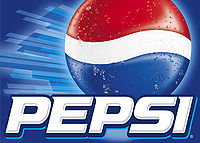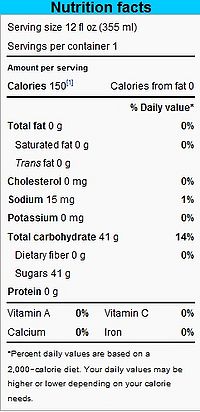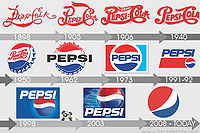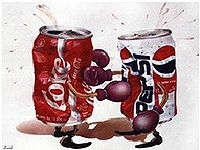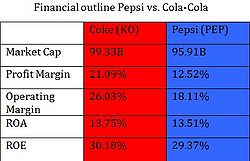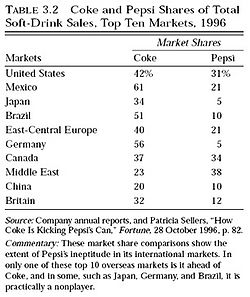Course:HIST104/99C-Pepsi
| Pepsi | |
|---|---|
| [[|200px|center]] | |
| HIST 104 - Topics in World History | |
| Section: | 99C |
| Instructor: | Joy Dixon |
| Email: | |
| Office: | |
| Office Hours: | |
| Class Schedule: | |
| Classroom: | |
| Important Course Pages | |
| Syllabus | |
| Lecture Notes | |
| Assignments | |
| Course Discussion | |
Pepsi
"The Joy of Cola"
Early History of Pepsi
The story of Pepsi began with Caleb Brenham, a pharmacist from North Carolina, who was behind the creation of Pepsi in 1893. At first the drink was simply called "Brad's drink", named after his Pharmacy, but was later renamed to Pepsi Cola in 1898 after pepsin and cola nuts were used in the recipe. The name Pepsi was created as Brenham believed that Pepsi could aid in digestion like a pepsin enzyme.[1]
After successfully creating his drink, Brenham attempted to get a trademark for his drink in 1902. However, Brenham was initially denied due to the existence of Pep Kola trademarked in 1896, which the patent office believed to be too similar in name to Pepsi Cola. Therefore, Brenham bought Pep Kola and its trademark for $100 and received the trademark for Pepsi.[2]
By 1910, Pepsi had sold more than 100,000 gallons per year across 24 states . [3] However, it when the Great War began, Brenham witnessed the fluctuating price of sugar, which he believed would continue to rise as the war continued. Therefore Brenham decided to gamble with the price of sugar and purchased massive quantities of it. Sadly, this was not the case and Brenham was forced sell his company in 1923 when he became bankrupt as a result.[4]
After the bankruptcy the company was sold to a Roy C. Megargel who too declared bankruptcy and sold the company in 1931 to Charles G. Guth, president of Loft Incorporated, who saw Pepsi as an opportunity to end his company's relationship with the Coca-Cola by using Pepsi as an alternative drink. Guth was successful in his management of Pepsi and despite the Great Depression, and even managed to expand the company by using clever marketing schemes such as offering 12 ounces of Pepsi for just a nickel, that was backed by their incredibly popular commercial jingle "Twice as much for a nickel". With these successes Pepsi eventually outgrew their parent company and changed it to Pepsi Cola Company.[5]
After the Second World War, Pepsi-Cola tried a marketing technique unique at the time, Walter Mack the president of the comapny decided that he would try to tap into the African American market. He accomplished this by hiring African Americans to work in his company and to create an advertisement specifically targeting the African American Population. The company's strategy worked and Pepsi's market share rose. However, this advertisement was not acceptable to some portions of society at the time and many conflicts arose within and outside the company. Conflicts that eventually led to the dismantling of the African American workers in the sales team in the 50s..[6]
Ingredients & Nutritional Information
- Carbonated Water
- High Fructose Corn Syrup
- Caramel Colour
- Sugar
- Phosphoric Acid
- Caffeine
- Citric acid
- Natural Flavours [7]
Pepsi uses a high fructose corn syrup instead of sugar, as a sweetener. However, the amount of corn syrup equals 41 grams of sugar in a 12 fl oz can. The corn syrup has been the beverage industry’s sweetener of choice for decades—largely because it has historically been much cheaper than sugar. Observers say the industry is testing the market amid mounting concerns about high-fructose corn syrup’s role in contributing to America’s obesity epidemic (although there’s not much evidence that sugar is any healthier) and the rising cost of corn-based products as more U.S. crops are diverted to production of ethanol-based fuels. The president of the U.S. Sugar Association, Andy Briscoe, said Pepsi’s move gives “shoppers another opportunity to choose natural sweeteners instead of manufactured ones” after the industry “rapidly introduced” high-fructose corn syrup to the North American market in the 1970s and 1980s. [8]
Environmental Issues
Water
Pepsi's main ingredient is water and they are striving to improve their water efficiency drastically. PepsiCo claims to make it their goal to improve water-use efficiency by 20 percent per unit of production by 2015 versus a 2006 baseline refers to global manufacturing operations as they existed in 2006, excluding major acquisitions in 2009 and 2010. For these operations through 2010, PepsiCo has improved water-use efficiency by 18.7 percent for foods manufacturing, and 17.8 percent for beverage manufacturing. These conservation efforts translate to a water savings of nearly 13.8 billion liters compared with the 2006 baseline. Pepsi is very concerned with conserving water in water-stressed regions and is making it their goal to improve water production conditions and implementing certain technologies to help water efficiency. In certain water-stressed regions, Pepsi is finding ways to improve water balance, based on the conditions, technologies and available resources in the specific areas. In South Chile for example, Pepsi farmers are improving water application efficiency by up to 35 percent. Pepsi's Frito-Lay facility in Casa Grande, Arizona, has been equipped with a state-of-the-art water filtration and purification system, which can recycle and reuse up to 75 percent of the water used in production. For 10 consecutive years, PepsiCo has significantly reduced the amount of water used to make their Frito-Lay products in North America. Similar technology is also being deployed in their Tingalpa facility in Australia, and in their first green plant in South America, Funza, Colombia—both water-stressed regions. In 2010, Pepsi's Funza facility was able to reuse 50 percent of its water not only contributing significantly to water conservation, but also adding an economic benefit in the process. The new technology makes it possible to recycle 4,228m3 of water monthly. In all these cases, PepsiCo is looking for ways to take the lessons learned in one facility and apply them to facilities across the globe for the benefit of local communities. Water flooding creates anaerobic and anoxic conditions in the soil that are conducive to the growth of bacteria that emit more methane (21 times the global-warming potential of CO2) and nitrous oxide (310 times worse than CO2) than what you would expect from dry/aerobic soil conditions.[9]
Packaging and Waste
Pepsi makes it their goal to use the most environmentally suitable packaging available in the country of operation. Pepsi has made it their goal to reduce their packaging footprint and have made huge strides in this area. Pepsi plans on developing the world's first 100 percent plant-based PET bottle made from fully renewable sources. This would reduce the carbon footprint made from their previous packaging of petroleum based PET bottles. Pepsi is also downgrading the amount of packaging used in their food packaging. They successfully down-gauged the film used for packaging their Frito-Lay and Doritos snack products, which reduced corrugate use by 414,000 pounds.[10]
Pepsi is committed to increasing the recyclability of their packaging and incorporating at least a 10 percent recycled polyethylene terephthalate.

The Evolution of the Bottle
With Pepsi, it's not what you're drinking anymore, it's what you're drinking from. In an impact to "Go Green" the bottle no longer only has the look and feel of plastic, but Pepsi’s new bottles won’t be as harsh on the environment as typical plastic. This is because the containers will be made entirely from plant material with the ingredient list reading like a tree-hugger’s smoothie: switch grass, pine bark and corn husks. Slashfood reports Americans use an estimated 200,000 barrels of oil each day in producing plastic packaging for our goods, including soda bottles. Pepsi’s new bottles, made 100 percent from plants, will emulate the look and feel of the bottles we’re all used to – the ones made from oil-guzzling, environment-killing PET plastic.
In an article written in Life Science Weekly, Pepsi was introduced with another eco-friendly headline, "Pepsi Reduces Plastic in Half-Liter Non-Carbonated Beverage Bottles by 20%".[11] The article, written May 20th 2008, states "Pepsi is introducing its lightest 500mL flavored non-carbonated beverage bottle yet. The company has reduced the plastic in this bottle by 20%, which will eliminate approximately 20 million pounds of waste from the environment. The lighter bottles will begin hitting store shelves this month. The new bottle will be launched in one of the beverage industry's fastest growing segments through established trademarks of Lipton Iced Tea, Tropicana Juice drinks, Aquafina FlavorSplash and Aquafina Alive. It will be available in 12-packs and 24-packs. In addition to a 20% reduction in the plastic resin, there will be a 10% reduction in the label size and a 5% reduction in the shrink wrap film used to wrap the multi-packs."[12]
Marketing & Commercials
The Pepsi Challenge
The marketing promotion strategy by PepsiCo is well known as The Pepsi Challenge. Collaborated in 1975, the challenge takes the form of a taste test. Pepsi representatives set up tables and booths in social locations such as malls and schools and entice people to take the Challenge. People are asked to taste a non-Pepsi product and a Pepsi product. They are encouraged to reveal what product they thought tasted best. Prizes are given to those who decide they preferred Pepsi.[13]
The Evolution of the Can
As with large corporations, sometimes the marketing strategy may not always be the best for the product. In March of 2011, Pepsi fell behind Diet Coke into third place after a release of information regarding a two-packaging related announcment. Right away, Pepsi announced that its Diet Pepsi would be offered in a "Skinny Can". This would be a taller, thinner can making it much like its older version of the product. Ricardo de la Blanca, CEO of DLB Group, believes that "if Pepsi wants to reinvigorate these two core brands, it should focus just as much on its overall marketing strategy as on its packaging."[14]
Unfortunately, Pepsi's attempts at marketing the Skinny Can was a failure. Critics such as The National Eating Disorders Association derided the sentiment of the Skinny Can which was marketed towards women and was another suggestion by the media that women could only be considered desirable if they were thin, tall, and beautiful. They claimed the marketing scheme of Pepsi "could trigger someone who is already vulnerable to negative body-image issues to start dieting or become more extreme in their dieting." [15] Diet drinks, eating disorders, along with smoking and drugs are a hidden secret of the glamourous world of modelling and fashion where girls are constantly scrutinized to look their best and their thinnest. Other critics agreed with The National Eating Disorders Association that Pepsi's marketing of the Skinny Can was inadvertedly encouraging girls to associate thinness with beauty and encouraging unhealthy eating habits with a focus on low-calorie foods or drinks over healthy nutrition. Faced with such negative controversy, Pepsi quickly apologized and removed the Skinny Can from its production and returned to their traditional-sized cans. [16]
A chance at the Superbowl
With the average 111.3 million viewers watching the 2012 Superbowl game where the New York Giants took on the New England Patriots, large corporations pay hefty bills to market their product and get a commercial on during the game. This year, Elton John made a Super Bowl commercial appearance in Pepsi's new ad, playing a harsh King who was pretty stubborn when it came to his musical taste. It's simple: If you can't sing, not only do you not get any Pepsi but you get dropped down into a dungeon. "X-Factor" winner Melanie Amaro also debuted in the commerical as part of her winner's package from the show.[17]
Pepsi vs. Coca-Cola
It is a well-known fact that Pepsis main rival is Coca-Cola. The two soft drinks are similar in many aspects, and basically share the same target group, marketing strategy and flavour. However, people tend to either be a Pepsi drinker or a Coca-Cola drinker, and will generally stick to their preferred drink when choosing which beverage to purchase. It is also a well-known fact that larger fast-food chains are known for exclusively selling either Pepsi or Coca-Cola. Before Pepsi came on the market in 1898, Coca-Cola had a monopoly on the soft drink market, selling a unique drink with a flavour not similar to any other drink. However, when Pepsi came on the market, Coca-Cola's unique flavour was not enough, and the fight over people’s choice began. Advertisement has been a focus for both Pepsi and Coca-Cola and both beverages have launched a large number of catchy commercials throughout the decades. In 2008, Pepsi launched a commercial with the slogan “Pepsi is #1”, putting Coca-Cola off. The use of celebrities is also a well known trick that both companies has taken advantage of, the following is an extensive list of celebrities used in the commercials for both companies.
Pepsi:
Cuba Gooding Jr., Tina Turner , Ray Charles , Spice Girls , Britney Spears, Jennifer Lopez, Beyonce Knowles , Justin Timberlake, Luke Rosin , Van Halen
Coca-Cola:
Selena Jerry Mathers, Ken Osmond, David Liesure, Ray Parker, Jr. Telly Savalas, Courteney Cox, David Arquette , Penelope Cruz
Despite Pepsi and Coca-Cola being more or less the same product, they advertise for different target groups. Pepsi's main focus in advertisement is directed towards young people, the marketing sector and insulting Coke. Coca-Cola focuses on refreshment, health and nutrition . Statistically speaking, Coca-Cola has a slight advantage in the global market, and studies have shown that the drink most commonly ordered in restaurants is Coca-Cola. The advantage Coca-Cola has on the market is however, marginal. In the United States, Coca-Cola owns around 30 percent of the market, while Pepsi own roughly 22 percent. Globally, the difference in preferences between the two soft drinks is somewhat more significant.
Financially, Coca-Cola produces better results than Pepsi, but, there is not a significant difference between the two companies on this aspect either.[19]
Pepsi and Coca-Cola are both brands within a chain of brand extensions and international brands, which produce other products apart from soft drinks. Pepsi is part of a larger brand co-corporation than Coca-Cola, which includes the Frito-Lays brands and the Pepsi-Cola Brands and the Quaker Brands. The Coca-Cola brand extension includes Diet Coke, Sprite, Fanta, Minute Maid, Powerade, Crush Sarsi, Sprite Ice, Fanta Orangoo and Qoo.[20]
References
- ↑ http://www.pepsistore.com/history.asp
- ↑ (http://web.archive.org/web/20080212003647/http://www.sodamuseum.bigstep.com/generic.jhtml?pid=3)
- ↑ (http://www.pepsi.com/PepsiLegacy_Book.pdf)
- ↑ (http://www.nytimes.com/2007/05/06/business/06boyd.html?_r=2&ref=obituaries&oref=slogin)
- ↑ (http://www.pepsi.com/PepsiLegacy_Book.pdf)
- ↑ (http://web.archive.org/web/20080212003647/http://www.sodamuseum.bigstep.com/generic.jhtml?pid=3)
- ↑ http://en.wikipedia.org/wiki/Pepsi
- ↑ Sorensen, Chris. "As the cost of corn syrup rises, sugar is coming back" The Pepsi Challenge: real sugar. http://www2.macleans.ca/2010/02/11/the-pepsi-challenge-real-sugar/ (accessed 29 March 2012).
- ↑ http://www.pepsico.com/Purpose/Environmental-Sustainability/Water.html
- ↑ http://www.pepsico.com/Purpose/Environmental-Sustainability/Packaging-and-Waste.html
- ↑ http://newsfeed.time.com/2011/03/26/cola-wars-revisited-coke-and-pepsi-duel-over-bottles-made-from-plants/
- ↑ http://www.lexisnexis.com.ezproxy.library.ubc.ca/hottopics/lnacademic/?shr=t&csi=303733&sr=HLEAD(Pepsi-Cola+Company)+and+date+is+May,%202008
- ↑ Thomas, Joe. 2009. The pepsi challenge. Marketing. Nov 18, http://exproxy.library.ubc/login?url=http://search.proquest.com/docview/214956586?accountid=14656(accessed March 28,2012).
- ↑ Kaplan, Andrew. 2011. The skinny on pepsp. Beverage world 130, (`821) (Apr 15): 56-57, http://ezproxy.library.ubc.ca/login?url=http://search.proquest.com/docview/926546177?accountid=14656(accessed March 29, 2012).
- ↑ Perton, Marc. "Does Diet Pepsi's Skinny Can Send The Wrong Message? - The Consumerist." The Consumerist. http://consumerist.com/2011/02/does-diet-pepsis-skinny-can-send-the-wrong-message.html (accessed March 29, 2012).
- ↑ Birkner, Christine, and AMA Marketing News. "Diet Pepsi's New Skinny Can: A Brand Heavyweight? - Perception Research Services International." Welcome to PRS - Perception Research Services International. http://www.prsresearch.com/prs-insights/article/diet-pepsis-new-skinny-can-a-brand-heavyweight/ (accessed March 29, 2012).
- ↑ http://www.huffingtonpost.com/2012/02/06/super-bowl-commercials-2012-pepsi-elton-john-video_n_1255376.html
- ↑ Pepsi, "Pepsi-King's Court Super Bowl," (February 2012). You Tube. http://www.youtube.com/watch?v=Rcf01QTcO6E (accessed 28 March 2012).
- ↑ http://complabs.nevada.edu/~canioj/mba795/cokevspepsi-final-ppt.pdf">
- ↑ Crawford, Ed, Merchant, Jennifer, Canio, Jonathan, Jiang Nanfeng, Park Jae, “Coke vs. Pepsi.” http://complabs.nevada.edu/~canioj/mba795/cokevspepsi-final-ppt.pdf
